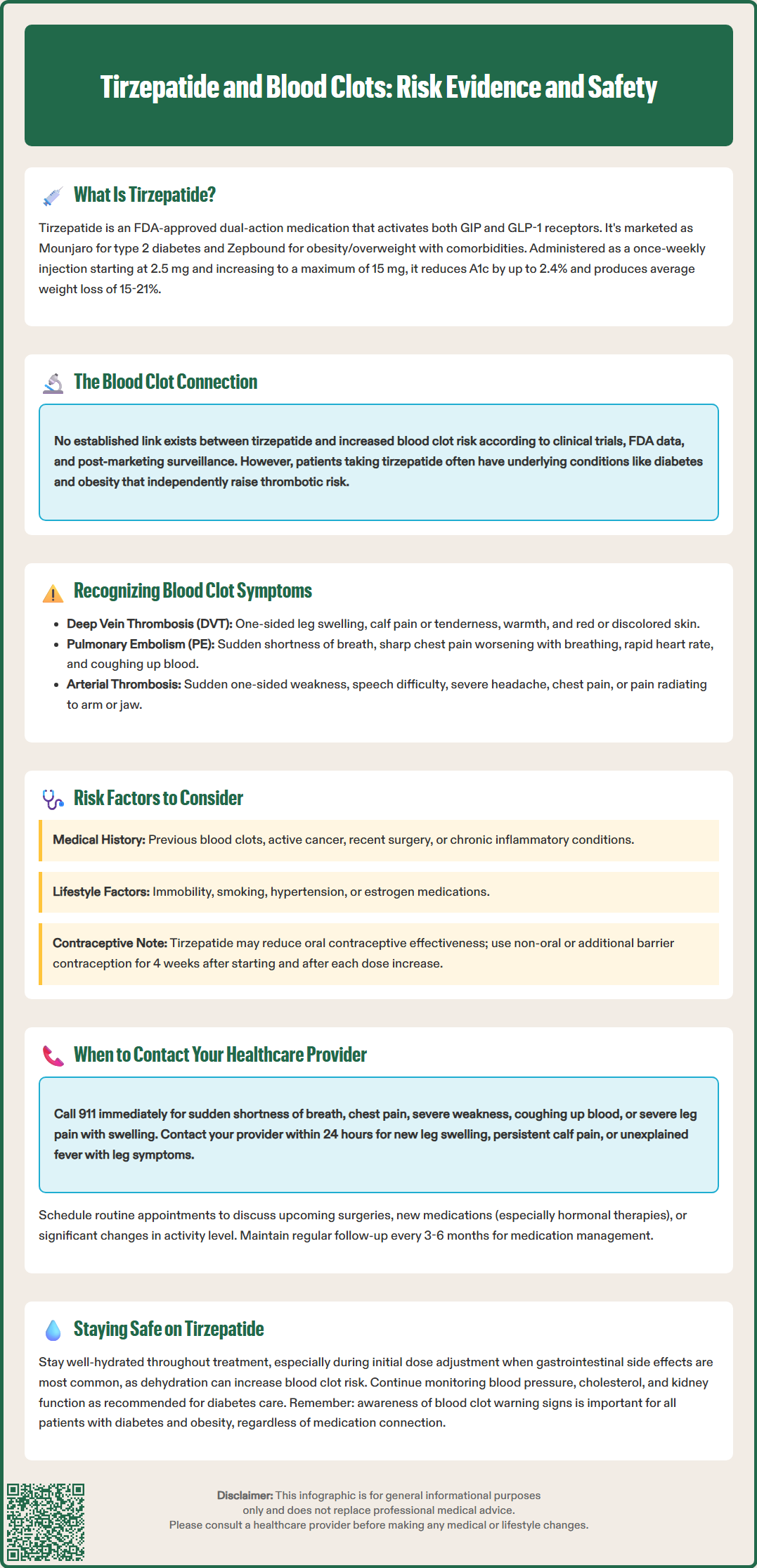LOSE WEIGHT WITH MEDICAL SUPPORT — BUILT FOR MEN
- Your personalised programme is built around medical care, not willpower.
- No generic diets. No guesswork.
- Just science-backed results and expert support.
Find out if you’re eligible

Tirzepatide (Mounjaro, Zepbound) is a dual GIP/GLP-1 receptor agonist approved by the FDA for type 2 diabetes and chronic weight management. As patients and clinicians consider this medication, questions arise about potential cardiovascular risks, including whether tirzepatide and blood clots are connected. Current clinical trial data and FDA prescribing information do not establish a causal link between tirzepatide use and increased thrombotic risk. However, patients prescribed tirzepatide often have underlying conditions—such as diabetes and obesity—that independently elevate cardiovascular risk. Understanding the evidence, recognizing warning signs, and maintaining appropriate monitoring remain essential for safe medication use.
Quick Answer: Current FDA prescribing information and clinical trial data do not establish a causal link between tirzepatide use and increased risk of blood clots.
Tirzepatide is a prescription medication approved by the FDA for the treatment of type 2 diabetes mellitus (marketed as Mounjaro) and chronic weight management in adults with obesity (BMI ≥30 kg/m²) or overweight (BMI ≥27 kg/m²) with at least one weight-related comorbidity (marketed as Zepbound). It represents a novel class of medication as the first dual incretin receptor agonist, activating both glucose-dependent insulinotropic polypeptide (GIP) and glucagon-like peptide-1 (GLP-1) receptors.
The medication works through multiple complementary mechanisms. Both GIP and GLP-1 receptor activation enhance insulin secretion in a glucose-dependent manner, meaning insulin is primarily released when blood glucose levels are elevated, reducing hypoglycemia risk. GLP-1 receptor activation also suppresses glucagon secretion, slows gastric emptying, and reduces appetite through central nervous system pathways that promote satiety.
Tirzepatide is administered as a once-weekly subcutaneous injection, with dosing typically initiated at 2.5 mg and gradually titrated upward by 2.5 mg every 4 weeks based on therapeutic response and tolerability. The maximum approved dose is 15 mg weekly. Clinical trials have demonstrated substantial reductions in hemoglobin A1c levels (up to 2.4% reduction at the 15 mg dose) and significant weight loss (average of 15% of body weight at 10 mg and 20.9% at 15 mg in the SURMOUNT-1 obesity trial).
Common adverse effects include gastrointestinal symptoms such as nausea, diarrhea, vomiting, and constipation, which are generally mild to moderate and tend to diminish over time. More serious but rare adverse effects include pancreatitis, gallbladder disease, hypoglycemia (when used with insulin or sulfonylureas), acute kidney injury (particularly with dehydration), and hypersensitivity reactions including anaphylaxis.
Tirzepatide carries a boxed warning for risk of thyroid C-cell tumors and is contraindicated in patients with a personal or family history of medullary thyroid carcinoma or Multiple Endocrine Neoplasia syndrome type 2. It is not indicated for use in patients with type 1 diabetes. Understanding these mechanisms and effects provides important context when evaluating any potential safety concerns, including questions about cardiovascular risks such as blood clots.
Currently, there is no established causal link between tirzepatide use and increased risk of blood clots (venous thromboembolism or arterial thrombosis) based on available clinical trial data and post-marketing surveillance. The FDA prescribing information for tirzepatide (Mounjaro and Zepbound) does not list thrombotic events as a known adverse effect. However, patients taking any medication should remain vigilant about recognizing symptoms that may indicate a blood clot, as early detection and treatment are critical for preventing serious complications.
Symptoms of deep vein thrombosis (DVT) typically affect the legs and may include:
Swelling in one leg, ankle, or foot
Pain or tenderness, often starting in the calf
Warmth in the affected area
Red or discolored skin
Unexplained leg pain, especially with unilateral symptoms
Symptoms of pulmonary embolism (PE), which occurs when a clot travels to the lungs, constitute a medical emergency and include:
Sudden shortness of breath or difficulty breathing
Sharp chest pain that worsens with deep breathing or coughing
Rapid heart rate or palpitations
Coughing up blood
Lightheadedness or fainting
Symptoms of arterial thrombosis (stroke or heart attack) require immediate emergency care:
Sudden weakness or numbness, especially on one side of the body
Difficulty speaking or understanding speech
Sudden severe headache
Chest pain, pressure, or discomfort
Pain radiating to the arm, jaw, or back
While these symptoms are not specifically associated with tirzepatide, any patient experiencing them should seek immediate medical evaluation regardless of their medication regimen. Patients with diabetes and obesity—the populations for whom tirzepatide is prescribed—may have baseline elevated cardiovascular risk, making awareness of these warning signs particularly important.

Although tirzepatide itself has not been linked to increased blood clot risk, patients prescribed this medication often have underlying conditions and risk factors that independently elevate thrombotic risk. Understanding these factors helps clinicians and patients make informed decisions about medication use and implement appropriate monitoring strategies.
Baseline cardiovascular risk factors common in patients with type 2 diabetes and obesity include:
Prolonged immobility or sedentary lifestyle
History of previous blood clots or thromboembolism
Active cancer or recent cancer treatment
Recent surgery, particularly orthopedic or abdominal procedures
Smoking or tobacco use
Hypertension and dyslipidemia
Family history of clotting disorders
Use of estrogen-containing medications (oral contraceptives, hormone replacement therapy)
Pregnancy or postpartum period
Chronic inflammatory conditions
Patients with obesity face additional thrombotic risk due to chronic low-grade inflammation, endothelial dysfunction, and increased prothrombotic factors.
The FDA prescribing information for tirzepatide includes specific contraindications and warnings. The medication is contraindicated in patients with a personal or family history of medullary thyroid carcinoma or Multiple Endocrine Neoplasia syndrome type 2. Caution is advised in patients with a history of pancreatitis, severe gastrointestinal disease, or diabetic retinopathy.
Women using oral hormonal contraceptives should be aware that tirzepatide may reduce the effectiveness of these medications due to delayed gastric emptying. The FDA recommends using a non-oral or additional barrier method for 4 weeks after tirzepatide initiation and for 4 weeks after each dose increase.
Tirzepatide is not recommended for weight loss during pregnancy, and the medication should be discontinued if pregnancy occurs. Patients planning surgery should discuss tirzepatide with their healthcare team, though recent guidance from the American Society of Anesthesiologists indicates most patients can continue GLP-1 receptor agonists perioperatively, with modifications only for those at high risk of gastrointestinal complications.
Clinicians should conduct a comprehensive cardiovascular risk assessment before initiating tirzepatide as part of standard care, particularly in patients with multiple thrombotic risk factors.
Patients taking tirzepatide should maintain regular communication with their healthcare team and understand when to seek medical attention. While routine follow-up typically occurs every 3-6 months for medication management and monitoring of glycemic control or weight loss progress, certain situations warrant more immediate contact.
Seek emergency medical care immediately (call 911 or go to the nearest emergency department) if you experience:
Sudden shortness of breath or difficulty breathing
Chest pain or pressure
Sudden weakness, numbness, or difficulty speaking
Coughing up blood
Severe leg pain with swelling and warmth
Loss of consciousness or severe lightheadedness
Contact your healthcare provider within 24 hours for:
New or worsening leg swelling, particularly if unilateral
Persistent calf pain or tenderness
Unexplained fever with leg symptoms
Skin changes such as redness or discoloration in the extremities
Schedule a routine appointment to discuss:
Plans for upcoming surgery or procedures requiring prolonged immobility
New medications, particularly hormonal therapies
Significant changes in activity level or mobility
Concerns about cardiovascular risk factors
Persistent or severe gastrointestinal side effects that may affect hydration status
Patients should also report common tirzepatide-related adverse effects that may indirectly affect thrombotic risk, such as severe vomiting or diarrhea leading to dehydration, which can increase the risk of blood clots. Maintaining adequate hydration is particularly important during the initial titration period when gastrointestinal symptoms are most common.
Healthcare providers should educate patients about the importance of maintaining mobility, staying well-hydrated, and adhering to any prescribed anticoagulation therapy if indicated for other conditions. Patients with diabetes should continue routine monitoring of cardiovascular risk factors including blood pressure, lipid panels, and kidney function as recommended by the American Diabetes Association Standards of Care.
For healthcare providers: When evaluating patients with suspected venous thromboembolism, use validated tools such as the Wells score to assess pretest probability. For patients with low or intermediate probability, D-dimer testing may be appropriate. Diagnostic imaging includes compression ultrasound for suspected DVT and CT pulmonary angiography or ventilation-perfusion scanning for suspected PE, following current US clinical guidelines. While there is no evidence linking tirzepatide to blood clots, vigilant monitoring and prompt reporting of concerning symptoms remain essential components of safe medication use.
No, current FDA prescribing information and clinical trial data do not establish a causal link between tirzepatide and increased blood clot risk. However, patients with diabetes and obesity may have baseline elevated cardiovascular risk independent of medication use.
Warning signs include sudden leg swelling with pain and warmth, shortness of breath, chest pain, coughing up blood, or sudden weakness and difficulty speaking. These symptoms require immediate emergency medical evaluation regardless of medication regimen.
Patients with history of blood clots, recent surgery, prolonged immobility, active cancer, smoking, or use of estrogen-containing medications have elevated baseline thrombotic risk. Comprehensive cardiovascular risk assessment should be conducted before initiating tirzepatide as part of standard care.
All medical content on this blog is created using reputable, evidence-based sources and is regularly reviewed for accuracy and relevance. While we strive to keep our content current with the latest research and clinical guidelines, it is intended for general informational purposes only.
This content is not a substitute for professional medical advice, diagnosis, or treatment. Always consult a licensed healthcare provider with any medical questions or concerns. Use of this information is at your own risk, and we are not liable for any outcomes resulting from its use.